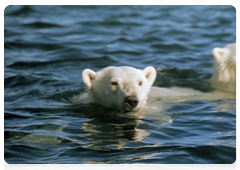MULTIMEDIA
 +
+
At present, the most serious threats that face polar bears are industrial development in the Arctic, such as shipping and oil drilling, habitat pollution and destruction, and poaching
 +
+
It took researchers who were working continuously under harsh weather conditions almost a month to catch and immobilise four male polar bears. Two polar bears were fitted with satellite-tracked collars
 +
+
The researchers rely on signals transmitted by the collar that is still attached to the animal for charting migration routes. Taking into account ice drifts in this area, the animal could travel at a speed of about 10 kilometres a day
 +
+
Researchers around the world usually place satellite-tracked collars on female polar bears as the shape of their heads and necks allows the animals to wear the collars for a long time
 +
+
During the expedition the researchers only encountered female polar bears accompanied by their cubs, and catching them would have jeopardised the life of the young. For that reason, they decided to attach collars to two males instead
 +
+
Aerial surveys and observations from helicopters also allowed the researchers to record the other animals inhabiting the area. All in all, the researchers counted 22 polar bears, including three females with cubs and a breeding pair
 +
+
Experts in various fields took part in the expedition: zoologists, environmentalists and climatologists, specialists on marine mammals, immobilisation specialists
 +
+
After the polar bears had been caught and immobilised the researchers took blood, fur and feces samples for genetic and veterinary analysis






 ABOUT THE PROGRAMME
ABOUT THE PROGRAMME
 POLAR BEAR RESEARCH: A HISTORY
POLAR BEAR RESEARCH: A HISTORY
 POLAR BEAR: LIFE, BEHAVIOUR AND MORE
POLAR BEAR: LIFE, BEHAVIOUR AND MORE
 VLADIMIR PUTIN'S VISIT
VLADIMIR PUTIN'S VISIT
 NEWS
NEWS
 MULTIMEDIA
MULTIMEDIA